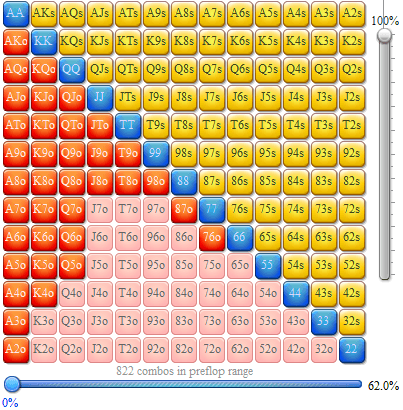Poker Hands To Raise Preflop
- Preflop Raise Size
- Preflop Hand Chart
- Texas Holdem Preflop Chart
- Preflop Raise Charts
- Preflop Strategy In Texas Holdem
I usually stick to a solid% range of hands where I go in on preflop, always folding the rest. But later into the tournament when blinds grow and antes start kicking in, people start to all-in early, I see 'a lot' of them betting with hands like J5o, 65s etc. Also having position on the SB is crucial which increases the EV of every single hand we are defending with. You might also wonder why we would be bluff squeezing with hands like KQo and JTs; I know that you find it very natural to call those hands. The answer is very simple. You don’t want to 3bet fold these hands and face a 4bet.
In short, your decisions in the pre-flop betting round should be based on three key factors:

- Your hand strength
- Your position at the table
- Your opponents’ action in front of you
We now look more deeply at how to apply these basics in the specific environment of the cash-game tables.
Hand selection
As in all games of Texas Hold’em, be it tournament play or a cash game, you will need to categorise your starting hand. (Refresh your memory of what we mean by “monsters”, “very strong hands”, “speculative hands” and “trash” in the Poker Basics lesson.)

By and large, it is correct to raise with monsters and very strong hands; it is better to be more circumspect with speculative hands; and trash should be thrown away. As you get more experienced you will add other factors, but the core decision is based primarily on that list.
However in a cash game, you will have a bigger stack compared with the big blind, so you can tend to play more speculative hands. The reasons for this are twofold: firstly we are risking a much smaller proportion of our stack to enter a pot pre-flop. Secondly, if we hit, we will win a far bigger pot.
Therefore the risk/reward calculation changes with 100 BB stacks in a cash game. In some instances we should be happy to call pre-flop with a hand that we might ordinarily throw away. (The notion of “pot odds” is discussed in more depth later.) You can afford to call and miss with speculative hands like smaller pocket pairs and suited connectors against raises, knowing that you will fold if you miss.
Preflop Raise Size
The larger stack sizes also free you up to play slightly unorthodox poker at times. You might want to call with a very strong hand instead of re-raising. Or you might want to call a re-raise with a weaker speculative hand.
Your decision will need to take into account the effective stack size, as discussed in the last lesson.
For example: You are on the button with 3♣3♠ and a very tight player raises from early position. It is very likely that he holds a big pocket pair, so you will need to hit a set to win.

If your assumption is correct and the tight player has a big pair like A♥A♦ or K♠K♣ it will be tough for him to get away from his hand on a flop like 3♦Q♦10♠. You are very likely to be able to get the maximum amount of chips in the pot.
Preflop Hand Chart
Therefore if the effective stack is 100 BB in this situation, you can certainly call the raise and hope to hit your set. The times you hit and win a big pot will make up for the times you miss and lose.
But if the effective stack is only 20 BB, you cannot win enough. Your relatively small profit will not make up for the times you miss. You should fold 3♣3♠ if you or your opponent is short-stacked.
Texas Holdem Preflop Chart
In later stages of tournaments, play like this this simply doesn’t work. You usually play with a shallow stack, where fancy moves can cost you your tournament life. That is not true in a cash game, where the small investment pre-flop can grow into a big one if you hit the right flop.
But always keep in mind that stack size is not the only factor in the decision whether you want to play a hand or not – always consider position, opponents and your table image.
Preflop Raise Charts

Preflop Strategy In Texas Holdem
Join us on our Discord channel.